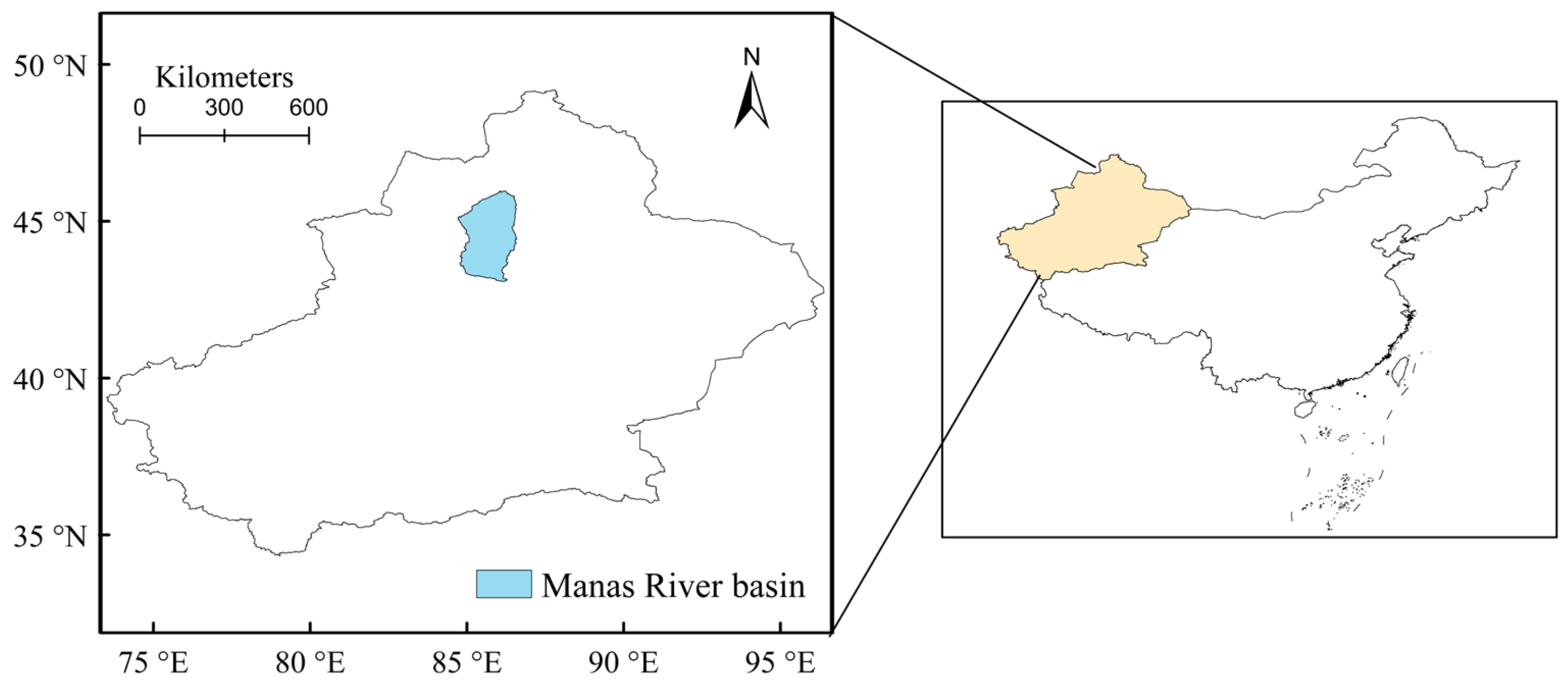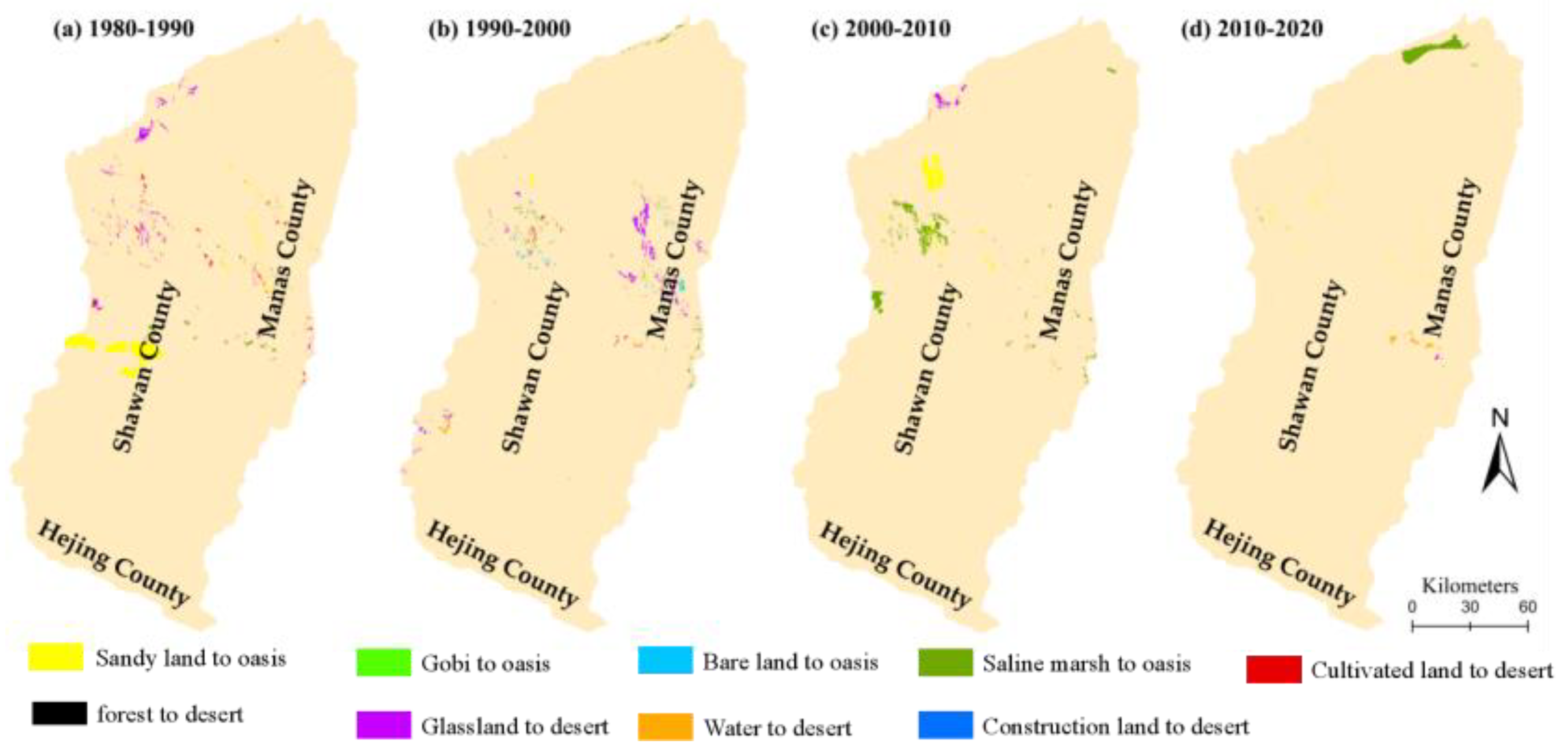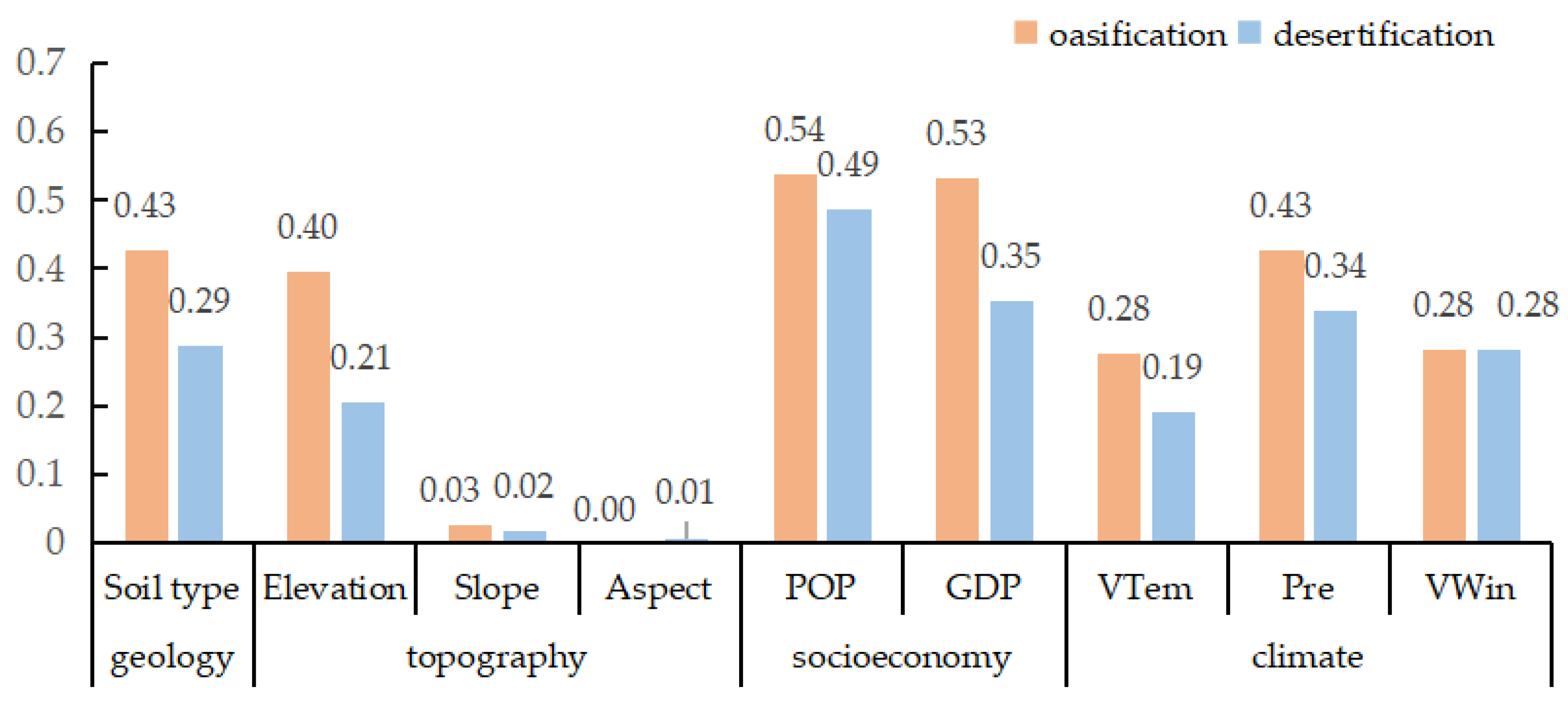3.1. Spatiotemporal Evolution of Oasification and Desertification
3.1.1. Oasis and Desert Structural Features
The structural changes of deserts and oases in the Manas River Basin from 1980 to 2020 are depicted in
Figure 2 and
Table 4. Among them, figures (a)-(e) represent land use distribution maps for the years 1980, 1990, 2000, 2010, and 2020, respectively.
The comparison reveals a slight difference in the overall area between the oasis and the desert. The ratio of the oasis area to the total area of the study area witnessed an overall trend of “increase-decrease-increase” from 1980 to 2020. The percentages for each year are as follows: 56.11%, 56.83%, 56.7%, 57.82% and 58.37%, respectively. Between 1980 and 2020, the oasis area in the study area increased by 757.34 km2, which is 4.03% higher than the initial oasis area. Simultaneously, the desert area as a whole displayed a fluctuating trend of decrease, with the ratio of the desert area to the total study area being 43.89%, 43.71%, 43.3%, 42.18% and 41.63% for the respective years. The desert area decreased by 757.34 km2 during this period, accounting for a 5.15% reduction compared to the initial desert area. In the oases, the cultivated land, construction land and water area increased significantly from 1980 to 2020, by 2036.53, 251.03 and 183.46 km2, respectively. Compared with the area in 1980, construction land had the most significant increase (86.39%), followed by cultivated land (34.91%) and water (20.65%). The overall area of grassland and forest decreased, by 1631.95 km2 and 81.74 km2, respectively, with a decrease of 14.51% and 15.14%. Among deserts, the area of sandy land and saline marsh decreased significantly from 1980 to 2020, by 438.83 and 307.11 km2, respectively, and compared with the initial area, saline marshes had the most significant reduction (59.46%), followed by sandy land (7.33%). In addition, the overall area of Gobi and bare land changed, but not significantly: the area of Gobi decreased by 13.97 km2, a decrease of 0.33%; the area of bare land increased by 2.57 km2, an increase of 0.06%.
A precise temporal scale characterizes the evolution of deserts and oases in the Manas River basin. In terms of oasis, the cultivated land had the most significant area change (2036.53 km2) in the last 40 years. From 1980 to 1990, the cultivated land area expanded by 137.00 km2. Subsequently, from 1990 to 2000 and from 2000 to 2010, there was a particularly notable increase in area, with expansions of 650.74 km2 and 782.28 km2, respectively. However, the expansion slowed down from 2010 to 2020, with an increase of 466.50 km2. The area of grassland decreased the most in the last 40 years (−1631.95 km2), not significantly in 1980–1990 (−28.25 km2) but declined precipitously in 1990–2000 (−672.71 km2) and leveled off in 2000–2010 and 2010–2020, but is still not negligible, with reductions of 441.26 and 489.73 km2, respectively. The land area for construction has changed considerably in the four time periods, among which 1980–1990 and 2010–2020 are more prominent, with an increase of 76.03 and 96.70 km2, respectively. In terms of the desert, the most significant change in sandy land area was observed between 1980 and 2020, with a substantial decrease in the area from 1980 to 1990 (−331.48 km2) and a significant increase from 1990 to 2000 (114.79 km2), which may be due to the rebound of the desert brought by desertification control. Saline marshes showed little change in area between 1980–1990 and 1990–2000 (71.93 and −60.71 km2) and decreased significantly between 2000–2010 and 2010–2020 (−190.32 and −128.02 km2).
3.1.2. Desert and Oasis Dynamic Degree Analysis
The rates of oasis and desert changes are shown by single and comprehensive dynamic degrees. As can be seen from
Table 5, the oasis dynamic degree in the Manas River basin was 0.08% during 1980–1990, indicating that the annual rate of oasis change was flat. Among them, the annual rate of change of construction land is the largest in absolute value (2.62%), followed by the annual dynamic degree of water area (0.46%), the annual dynamic degree of cultivated land and forest land is similar in absolute value, and the annual dynamic degree of grassland is the smallest in absolute value (0.03%).
The rate of oasis change accelerated from 1990 to 2000, with a comprehensive dynamic degree of 0.38%. Among them, the absolute value of the forest dynamic degree is the largest, 1.41%, the middle of cultivated land and construction land dynamic degree and the smallest of grassland and water dynamic degree.
The rate of change of oasis slowed down in 2000–2010 and 2010–2020, with comprehensive dynamic degrees of 0.33% and 0.30%, respectively. In the first ten years, the rate of change of cultivated land was the largest, with an absolute value of degree of 1.18%, followed by construction land, grassland, forest land and water area. In the latter ten years, the absolute values of construction land and water dynamic degree were the largest, with 2.17% and 1.21%, respectively, while the absolute values of dynamic degree for cultivated land and grassland are in the middle and the absolute value of the dynamic degree for forest was the smallest.
Regarding deserts, the comprehensive dynamic degree of deserts during 1980–2020 was larger only in 1980–1990 and 2000–2010, with 0.15% and 0.14%, respectively, and 0.07% in the other two periods. Regarding single dynamic degree, saline marshes are the largest in absolute value in all four periods, followed by sandy land. The Gobi and bare land dynamic degree are basically zero.
Among the dynamic degree, construction land and cultivated land in oasis are the land types constantly changing, consistent with the conclusion in the structural analysis above. Forest and water are occasionally active, and grassland is relatively stable, which contradicts the structural change analysis above that grassland has the most significant reduction in area, which the large base of grassland area may cause. The reduction of grassland area in each period has little impact. Saline marshes are the most active land type in deserts, followed by sandy land, and the most stable desert land types are Gobi and bare land.
3.1.3. Temporal Characterization of Oasification and Desertification
The land transfer model was used to acquire the temporal change characteristics of desertification and oasification interconversion using ArcGIS 10.7 software (
Table 6,
Table 7,
Table 8 and
Table 9).
The temporal characteristics of oasification were analyzed by considering the oasis as a whole and the desert, Gobi, bare land and saline marsh as individual units. The areas shifting from desert to oasis exhibited a “decreasing-increasing-decreasing” trend. The conversion areas were similar between the periods of 1980 to 1990 and 2000 to 2010, amounting to 410.64 km2 and 413.85 km2 respectively. The smallest conversion area was observed from 1990 to 2000, with a measurement of 125.04 km2, followed by 154.48 km2 from 2010 to 2020. Next, the temporal characteristics of desertification are analyzed by taking the desert as a whole, taking the cultivated land, forest, grassland, water and construction land as units. Specifically, 1980–1990, 1990–2000, 2000–2010 and 2010–2020 oasis-to-desert conversion areas are 170.58, 169.79, 35.83 and 29.60 km2, respectively, showing a continuous decrease trend.
In the oasification, the area converted from saline marsh to oasis gradually increased from 1980 to 2010, reaching a peak of 222.07 km2 in 2010, then decreased from 2010 to 2020. The conversion area of sandy land to oasis showed a fluctuating downward trend, with the maximum area (369.44 km2) in 1980–1990 and the minimum area (19.35 km2) in 1990–2000. The conversion of bare land to oasis increased first and then decreased throughout the study period. Still, the total transformation was insignificant (46.33 km2), while there was almost no conversion of Gobi to oasis (19.37 km2). During 1980–2020, sandy land and saline marsh conversion to oasis accounted for 94.39% of the total conversion area. Thus, saline marsh and sandy land were the primary sources of oasis conversion.
Among desertification, grassland was the primary source of desert in 1980–1990, 1990–2000 and 2000–2010 with 65.19%, 75.55% and 90.81% contribution, respectively, but its contribution declined in 2010–2020 with only 13.94%. Cultivated land was the secondary source of desert in 1980–1990 and 1990–2000 with 34.72% and 11.66% contribution, respectively, but its contribution decreased in 2000–2020 with almost 0. Watershed contributed less to desert in 1980–2010 with 0.08%, 8.1% and 8.13%, respectively, and became the main source of desert in 2010–2020, with a contribution rate of 85.65%. The contribution rate of forest to desert increases first and then decreases and reaches its peak (4.69%) in 1990–2000. The contribution rate of construction land is the lowest, and its value is almost 0 in four periods. The contribution of desertification is ranked as follows: grassland > cultivated land > water > forest > construction land. Therefore, grassland and cultivated land are the primary sources of desertification.
Overall, the existing land use pattern in the Manas River basin results from the interaction of both oasification and desertification. Desertification shows a continuous decreasing trend, while oasification shows a “decreasing–increasing–decreasing” trend. In 1980–1990, the area of oasification was higher than the area of desertification; in 1990–2000, desertification was higher than oasification; and in 2000–2020, oasification was higher than desertification, which indicates that the Manas River Basin is currently in the stage of oasis expansion.
3.1.4. Spatial Characterization of Oasification and Desertification
Through ArcGIS 10.7 software, the spatial distribution map of the mutual transfer of oasis and desert was output (
Figure 3) to obtain the spatial characteristics of desertification and oasification in the Manas River basin.
Figure 3a shows the spatial distribution of oasification and desertification in the Manas River basin during 1980–1990. Oasification is mainly distributed in the central and west-central part of the study area, within Shawan County and Dushanzi District, within the grassland, and a small part is located in the north-central part of Manas County. At the same time, desertification is heavily concentrated in the north-central and west-central parts of the study area, mainly located in the interlacing zone of oasis and desert or Gobi.
Figure 3b shows the spatial distribution of oasification and desertification in the Manas River basin from 1990 to 2000. Oasification is mainly located in the north-central part, where oasis and desert are interspersed. At the same time, desertification is heavily concentrated in the northern part of Manas County, and a small part is located in the mosaic of desert and grassland in Usu City.
Figure 3c presents the spatial distribution of oasification and desertification in the Manas River basin during 2000–2010. Oasification is mainly distributed in the western part of the study area, within Shawan County and Kuitun City, with sandy land and saline marsh as the main transformers. At the same time, grassland is the primary source of desertification, mainly within the alkaline zone.
Figure 3d shows the spatial distribution of oasification and desertification in the Manas River basin during 2010–2020, during which oasification was mainly located in and around Manas Lake and desertification was located primarily on the northern administrative boundary of Shihezi City.
During 1980–2020, the spatial distribution of oasification shifted from central to east-west and then to northeast, and the spatial distribution of desertification shifted from east-west to east-central. In the past 40 years, the areas that are more prone to oasification are located in deserts within grasslands, where deserts and oases border, followed by saline marsh, and finally where Gobi and oases border, with sandy land more easily transformed into grasslands and saline marsh transformed into waters. The Gobi and bare land are more solid and less likely to be changed. The areas more prone to desertification are also mainly located where grassland, cultivated and sandy land border and construction land and water. Grassland and cultivated land are more likely to be transformed into desert, while forest is the most stable and less susceptible to desert erosion. Overall, oasis and desert transformation are more intense at the intersection of oasis and desert, and more prone to oasification or desertification. Sandy land and saline marsh are more prone to oasis, grasslands and cultivated land are unstable and more prone to desertification, and forests are the most stable and less prone to desertification.
3.2. Analysis of Driving Factors
3.2.1. Detection of Single Factor
A geographic detector was applied to reveal the primary factors driving the spatial and temporal evolution of oasification and desertification in the Manas River basin. The area of sandy land, Gobi, bare land and saline marsh transformed into oasis is taken as the dependent variable Y1, and the area of cultivated land, forest, grassland, water and construction land transformed into desert is taken as the dependent variable Y2. The geographic detector explores the degree of influence of geological, topographical, socioeconomic and climatic factors on oasification and desertification. q values in the results (
Figure 4) are the required driving force. p values are significance levels, and the vast majority of p-values in the results are 0, indicating that the results are significant and that the driving force of the driving factors on the dependent variables is credible.
The q-values of the driving factors affecting oasification in the Manas River basin are ranked as follows: Population density > Average land GDP > Soil type > Annual precipitation > Elevation > Average annual wind speed > Average annual temperature > Slope > Aspect, with most q-values below 0.3. The contribution of population density, average land GDP, soil type and annual precipitation to oasification (all greater than 0.4) is significantly more substantial than other factors, indicating that these four factors are the key factors driving oasification in the Manas River basin. These are followed by elevation, mean annual temperature and mean annual wind speed, which had q-values of 0.395, 0.276 and 0.282, respectively, with driving rates above 28%, indicating that these factors significantly influence oasification.
The q-values of the driving factors affecting desertification in the Manas River basin are ranked as follows: Population density > Average land GDP > Annual precipitation > Soil type > Average annual wind speed > Elevation > Average annual temperature > Slope > Aspect. The q-values of population density and averaged land GDP among the socio-economic factors were 0.488 and 0.354, respectively, with a driving rate of more than 35%, which were the key influences driving desertification in the Manas River Basin. And the q-values of annual precipitation, soil type, average annual wind speed, elevation and average annual temperature were 0.34, 0.288, 0.281, 0.206 and 0.191, respectively, with a driving rate of more than 19%, which had a more significant influence on desertification. In contrast, the q-values of slope and aspect among the topographic factors were 0.018 and 0.005, respectively, with a driving rate of less than 2%, which had a lesser influence on desertification.
3.2.2. Interaction Detection of Dual Factor
Using nine types of driving factors for interaction detection, the results (
Table 10 and
Table 11) present that the q-values of the interactions were all greater than the maximum of the q-values of any two factors or the sum of the two, for two-factor enhancement or non-linear enhancement, weakening or independent of each other does not exist. It indicates that the results of oasification and desertification in the Manas River Basin are driven by multiple factors together. The larger the interaction q value of the two factors, the higher the influence of two-factor interaction on oasification or desertification.
The six groups with the highest interaction driving force in the oasification process in descending order were: average land GDP and elevation, mean annual temperature and average land GDP, average land GDP and soil type, annual precipitation and average land GDP, average land GDP and population density, mean annual wind speed and average land GDP, and population density and elevation, and all six groups interacted at more than 64%. And after interacting with other factors, the driving force of economic factors increased significantly. The single slope and aspect factors had minor oasification driving forces. However, after interacting with other factors, the driving force increased significantly, and all showed non-linear enhancement.
In the desertification process, after the interaction of driving factors, the driving factors with higher driving forces in order are the interaction of mean annual wind speed and population density with a driving force of 0.614; the interaction of population density and elevation with a driving force of 0.602; the interaction of annual precipitation and population density with a driving force of 0.601; the interaction between population density and soil type is the same as the interaction between mean annual temperature and population density, both with a driving force of 0.6. The driving force of a single climatic factor on desertification in the Manas River basin is weak. Still, it is higher than that of climatic factors interacting with other factors after interacting with social economic factors. This suggests that the climatic factors will significantly affect the transformation of the oasis into desert after the population and economic factors reach certain climatic conditions.











